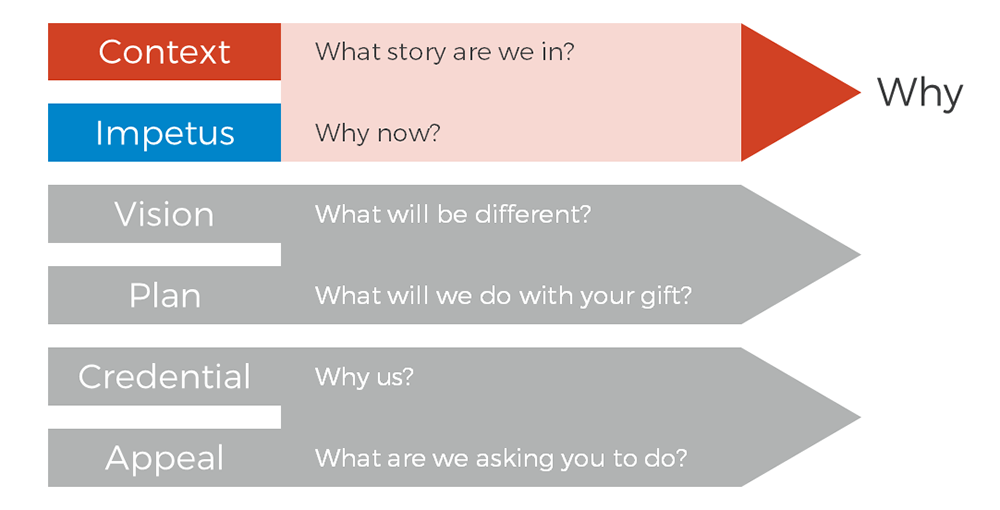

The state of the world has made us want to connect with more of you, more often. For the rest of 2020, the Campbell & Company Communications team is sharing a new article every week that explores a topic in case development and fundraising communications, drawn from our work.
Whether it’s thinking about how to approach fundraising communications against the backdrop of current events or tackling an evergreen challenge we see time and time again in nonprofits across the sector, these articles focus on practical tips to empower fundraising leaders in their day-to-day work. Subscribe to the series here.
We’re kicking off Fundraising Communications Weekly with a deep dive into the Six Elements of Your Case for Support—the foundation for strong donor messaging in everything from major gift cultivation to annual appeals. In Part 1, we introduced the six elements on a conceptual level—now it’s time to see how they work in practice.
We’ll demonstrate with a fairly down-the-middle example: a $5 million capital campaign to build a new home for a neighborhood food pantry. In most case development exercises, it doesn’t take all that long to get to a workable outline of six elements with initial draft messaging that is a little undercooked, overbroad, or less than special. The real work is pushing each of your six elements further until they feel genuinely strong.
Now, to our food pantry…

Context is framing information about the world around you that gives your case meaning. A weak-but-workable context message here might speak to the general problem of hunger in America or tough economic times—true enough, but hardly a revelation and a little too likely to blend into the background of concern-worthy causes.
A stronger version would key into the fact that the food pantry is in a well-off neighborhood where people often don’t realize how many of their neighbors struggle with poverty and hunger:
In one of our city’s wealthiest neighborhoods, one in nine people struggle with poverty. Every year, thousands of our neighbors find themselves unable to afford food for themselves and their families. [expand from here with stats and stories]
This not only makes the case more specific, but also creates an element of interest, learning, even surprise for the donor. It’s easier to imagine them remembering it and passing it on to other people in their lives.
The Impetus is your place to create a sense of moment, urgency, and stakes—to provide the spark that might cause someone to change their giving behavior now.
When Impetus is done poorly, it often takes the form of an empty “now more than ever.” We have to make a real claim here, and our food pantry has a few different cards to play.
They could mount a threat-based argument driven by the direness of the statistics:
Unless we act today, thousands of our neighbors will live without knowing where their next meal will come from—and every day they spend worrying about food is a day they can’t dedicate to building their path out of poverty. Thousands of children in our neighborhood will go to school hungry—affecting their academic performance today and their lives tomorrow.
Although there is no “new” information here, this creates the sense of a decisive moment and attaches some of the basic information of the case (from the Context) to a feeling of now. You hear the clock ticking.
The Impetus could also take the form of a moral challenge to the community:
How we respond to the crisis of hunger in our community will show the depth of our values—and who we are as a community. It’s time to show that our community takes care of our neighbors, no matter what.
Here the urgency is less time-specific (though the “It’s time” is doing a bit of work for us) and comes from the sense that who we are as people is being called into question. A growing body of persuasion research suggests that appeals to values and identity—like these—are among the most powerful drivers of behavior change.
Finally, the Impetus can use a positive aspiration/opportunity-based framing—in this case arising from the once-in-a-generation nature of the campaign, which was made possible by an extraordinary real estate opportunity:
Today, after 50 years of making do in rented spaces that were never designed for our mission, we have an opportunity to build a new permanent home.
Again, there’s a sense of moment, but it’s a time-sensitive window of opportunity rather than a ticking time bomb.
These three different angles—threat, moral challenge, opportunity—are quite universal in fundraising cases, and you can use any and all of them in different combinations. Just note that each brings a different emotional tone and color to your case, and take care to weave them together in a cohesive way. Rapid shifts in voice and tone can undermine the credibility and impact of any communication.
The Vision element is a depiction of a future state that your donor can picture in their mind. This can be a challenge with capital campaigns because the temptation is to just sell the building and its exciting features. Here’s what that weak version would look like for our food pantry:
A state-of-the-art 20,000-square-foot permanent home for our mission
This paints a picture, and the picture is a building. What about the people? A stronger version might speak more to what will be different in human terms:
A state-of-the-art facility that doubles our service capacity and ensures dignity in every experience for our clients
Better—and potentially good enough. But for this specific campaign, there’s a bigger vision: They’re not just increasing space for food service—they’re designing the facility with space for collaboration with partner agencies and individual case management so that when people come in the door for food, they can get connected to a whole range of other social services to help them get back on their feet in all areas of their lives. Here’s that vision:
A new kind of food pantry that helps people chart a path out of poverty
This vision not only resonates more deeply and expresses creativity and leadership—it also potentially gets past the donor concern of giving money to an endless problem, which every food pantry faces.
The Plan element conveys the programmatic substance or detail underneath the Vision, and the primary goal is to build confidence in the project.
For capital projects like our food pantry campaign, this part is usually fairly straightforward, and sometimes a little too easy. The weak version is simply to list features:
20,000 square feet, four private offices for individual client consultations, spacious lobby with a welcoming front desk, XYZ cold storage capabilities for fresh food, etc.
The challenge is to synthesize features into benefits. An easy way to do this is to try to express the top three to five benefits that your project will deliver:
Our new permanent home will be:
Designed from the ground up for our mission and for the dignity of our clients
Ready to meet the full need in our community, serving hundreds more people every week
Built to connect our clients to a wide range of social services on site to help them chart a path out of poverty
Every one of these might then key into a number of supporting features or facts—but they’ll now be supporting an easily digestible message focused on benefits.
The Credential consists of information about the organization that builds the prospect’s trust and confidence. This usually isn’t that hard to develop—the key is to make sure you don’t overplay it at the expense of the other elements, because this is typically a supporting message, not a lead message. It’s how a donor’s brain comes to sign off on a giving decision the heart has already made in response to the more soul-stirring elements of the case.
Our food pantry has plenty to deliver here:
Over 50 years of service to our community, we’ve built one of the largest food pantries in the city—and a model for pantries across many other neighborhoods.
We’ve helped tens of thousands of people keep their children from going to school hungry, live with dignity in old age, or get back on their feet after an unexpected job loss.
[Expand with endorsements from trusted officials, stories of impact, proof points, etc.]
Of all the elements, the Credential is the most flexible in where and how you can deploy it: all together in a standalone “about us” page; broken out into sidebars, feature stories/case studies, and supportive quotes wrapped around the core case narrative; or woven in at a paragraph and sentence level throughout the case.
Having all these options at your disposal is useful because big chunks of Credential can be somewhat disruptive. In a rich narrative flow building from Context to Impetus to Vision, it can feel like a momentum-killer to suddenly detour into your 50 years of history and brag points.
How we frame the appeal suggests the story that the donor gets to tell themselves about their gift—which is the main thing they get in exchange for their gift. In an individual major gift solicitation, we will tailor this entirely for the donor…but at the same time, we’ve got to put something in the brochure, so we have to commit to a general appeal statement as well.
For our food pantry, it comes back to being a good neighbor and reinforcing the Vision statement, which is the strongest aspect of the case:
Step up today to help thousands of our neighbors build a path out of poverty.
Nothing mind-blowing, but hopefully the decision is already made by the time you get to delivering this.
You can see how our food pantry answered the core question that each element raises—and how they pushed themselves a little further to go from a weak to a strong version. This is how you build a case that’s strong from top to bottom and front to back.
We’ll return to the Six Elements in many future articles and webinars—we hope you’ll stay tuned and get started in thinking through your case today.